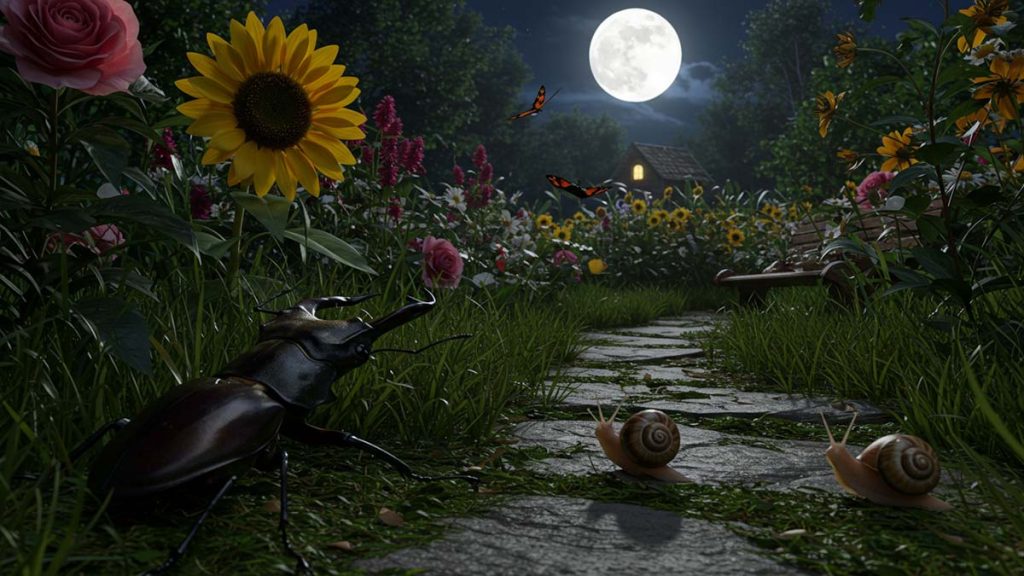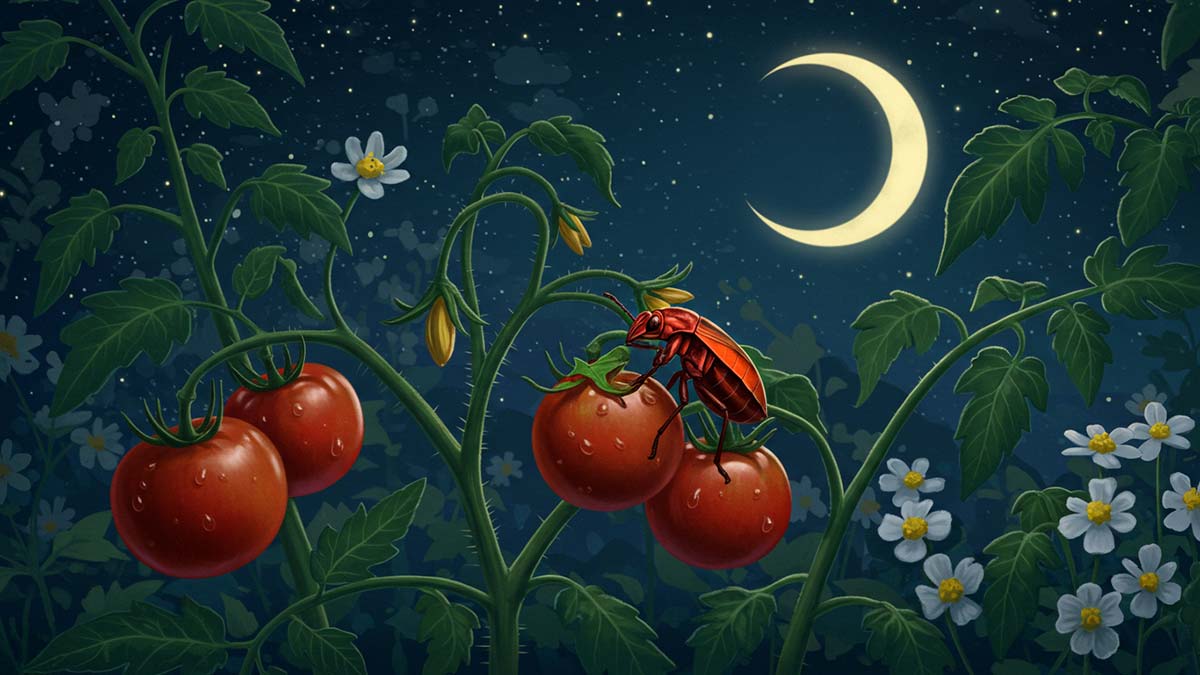Last Updated on August 1, 2025 by Avia
You know me. I love a good garden. They make for excellent projects, wicked-awesome therapy, and the fruits of all your labor? Ultra rewarding! But there are a lot of usurpers out there that can threaten the thrivy-vibe of a garden. You know what I mean. Slugs, aphids, spider mites…oh my! If you’ve ever walked out to check your plants and found an explosion of chewed leaves or sneaky nighttime visitors, you know what I mean. But what you might not know that bugs and the moon might play a big role in how healthy your garden grows (and how buggy it might bet). I’m not talking about a “blame Mercury retrograde” kind of way. I’m talking about something surprisingly practical: how moonlight affects pest behavior, and how you can use that knowledge to get ahead of them.
Let’s break it down.
Wait, What? The Moon Affects Bugs?

Yup. The moon doesn’t just pull the tides and inspire werewolf stories. Moonlight affects pest behavior too.
That glow in the sky changes over a 29.5-day cycle, moving through phases like new moon, full moon, waxing, waning, and all the crescenty bits in between. And as the moon brightens or fades, the light levels at night shift, altering how insects and rodents act.
Many pests are nocturnal, and they use moonlight (or the lack of it) to decide when to move, feed, or even mate. So understanding the lunar rhythm isn’t mystical; it’s tactical.
So, What Happens During Each Moon Phase?
Let’s keep it simple:
- Full Moon = Bright nights. Some pests become more active (such as flying, feeding, and mating), while others hide to avoid predators.
- New Moon = Dark skies. Activity often dips. Fewer bugs, less movement.
- Waxing/Waning Phases = Transitional times. Movement fluctuates, but patterns are still there if you look closely.
What this means for you: your timing matters. If you spray during a low-activity phase, your treatment might last longer. If you plant during a pest-heavy period, your crops might take a hit.
Real-Life Evidence: Bugs That Party Under the Full Moon
There’s science behind this. Studies show insects like aphids, beetles, and moths become noticeably more active under brighter skies. Some navigate by moonlight. Others feed more aggressively when they can see better.
Meanwhile, rodents (especially the ones that sneak through gardens or compost bins) sometimes move less during full moons to avoid predators. But if they’re hungry or bold, they still show up.
Even poop sightings increase during bright lunar phases. (And yes, if you’ve ever Googled “What does skunk poop look like?” after finding something questionable near your shed, now you know: it might show up more often around a full moon.)
Using the Moon to Time Pest Control
You don’t have to be a lunar expert to apply this in your yard. Here’s how you can use the moon to your advantage:
Full Moon: Watch & Document
You’re likely to see more insects during this phase. Use the time to monitor which pests are showing up and where. This is when your traps, cameras, or observation notebook come in handy.
Waning Moon: Take Action
Pest activity starts to drop here. It’s a smart window for spraying natural deterrents, applying oils, or releasing beneficial insects like ladybugs. You’re hitting pests when they’re still around but slowing down.
New Moon: Reinforce Defenses
Lower activity means you can get ahead. Seal gaps, trim back plants, clear debris, and plant pest-resistant varieties. Think of it as a quiet time to prep before the next surge.
My Experience: What Gardeners Notice in Arlington, TX

If you didn’t already know, I’m a native Texan. While I was working at the University of Texas as the doctoral director for the School of Social Work, I had a garden. In North Texas, especially places like Arlington (where my university is), local gardeners have long noticed bug patterns that match the moon. Self included.
Right around the full moon, they report spikes in damage from chewing insects and beetles. Some even find increased wildlife activity, including droppings left by skunks, raccoons, or opossums.
One of my neighbor gardening enthusiasts described it best: “It’s like the pests wait for the spotlight to come on, and then boom. They’re everywhere!”
What About Zodiac Signs and Astrology?
Alright, now we’re veering into the woo-woo zone, but stick with me.
Some growers (notably in biodynamic farming) believe the moon’s position in the zodiac also matters. For example, when the moon is in a water sign like Cancer, pests that affect fruiting plants might show up more. During earth signs like Virgo or Capricorn, pests that attack roots could be the issue.
Does this work? Maybe. Maybe not. But if it helps you create a routine and stay more aware of what’s happening in your garden, it’s worth a try.
Moonlight and Poop? Yep, Even Wildlife Leaves Clues
This might sound weird, but if you start tracking the moon, you’ll also notice changes in signs like droppings around your property.
Take skunks, for example. People often ask: What does skunk poop look like? It’s usually dark, twisted, about 1–2 inches long, and often full of seeds or insect parts.
If you start seeing more of it during full moons, that’s no coincidence. Increased animal movement under brighter skies can leave behind more clues (sometimes quite smelly ones).
Pest Control That Works With the Moon (Not Against It)
You don’t need to overhaul your life. Just consider tweaking your pest control strategy with these steps:
- Use a moon phase calendar (plenty of free apps out there).
- Monitor pest behavior each week, especially during full moons.
- Plan major treatments during waning or new moon phases.
- Use preventive methods (like sealing cracks or planting companion crops) during the quieter phases.
- Pay attention to droppings or animal activity patterns. Even a pile of skunk poop can tell you something.
Not Working? Bring in the Pros
Let’s be honest: sometimes, no matter how moon-savvy you are, you still end up with pests you can’t shake.
That’s when it’s time to call a wildlife and pest control team that understands both the science and the season.
Critter Stop offers expert help for pest and wildlife problems (skunks included!) I remember my neighbor in Arlington having a Critter Stop pro come out to his home when he had some pretty pesky pest problems. They did a fabulous job. Whether you’re dealing with mysterious droppings, nightly damage, or full-blown infestations, they’ll inspect your space, clean it up, and help keep the critters from coming back. Call (214) 234-2616, or visit Critter Stop to book your free inspection.
FAQs About How Moonlight Affects Pest Behavior
Yes, indeedy. Especially nocturnal pests. Many insects and animals adjust their movement based on light levels, which change with the moon.
During the waning moon or new moon phases. Pests are generally less active, so treatments stick around longer and face less resistance.
Moths, aphids, beetles, and certain rodents are all known to shift behavior based on moonlight levels.
Skunk droppings are dark brown or black, twisted like a soft rope, and often contain undigested food like seeds or insect shells.
You bet they do (at least, savvy gardeners do). Farmers and gardeners have done it for centuries. It’s not magic, it’s just working with natural rhythms.
If you’re still seeing consistent damage or activity, call a professional like Critter Stop. Some pests don’t play by the rules.
Last Thoughts About Garden Bug Blues
I hope these insights into how moonlight affects pest behavior gave you some valuable tips to move forward with better strategies for a super-happy & healthy gardening experience. Just remember, pests are inevitable, but they’re also a part of the cycle of life. They’re also symbolic. So, perhaps instead of getting frustrated (and believe me, that’s a natural response when you see your tomato plants or peonies inundated with creeper-crawlies), you could endeavor to see the bigger (and symbolic) picture. At any rate, thank you (as always) for reading, and I wish you all the fairest, merriest garden in the land.
Mighty brightly,

© Copyrighted. All Rights Reserved.
Want more? Me too! That’s why I’ve also got this for you on Whats-Your-Sign:











